A history of Woodley churches
The following account tells the story of Christian worship in Woodley and the buildings in which it took place, by the people of Woodley, over a period of more than a thousand years, during which time the population has grown from almost nothing to nearly 35,000.
Pre-Reformation
To start, at the very beginning of Woodley church history we have to look to Sonning, because from earliest times Woodley was in the Parish of Sonning. It is thought that the first church in Sonning was built in Anglo Saxon times, by the 7th century monk, St Birinus, who was the first Bishop of Dorchester. St Birinus was a missionary priest sent to England by the Pope in Rome, just as was St Augustine, who became the first Archbishop of Canterbury.
In the 7th century this part of the country was in the Kingdom of Wessex and in 634 Dorchester Abbey became the Cathedral of Wessex, prior to its move to Winchester in 660. Over the next 250 years Winchester Diocese was divided several times and in 909 one of the smaller Dioceses created was that of Ramsbury & Sonning.
Thus, Sonning church became one of the twin Cathedrals for the Bishop of the new Diocese, the other being Ramsbury, near Hungerford. It retained this status for about 150 years, but after several further Diocesan reorganizations, Sonning became part of Salisbury Diocese, when it was founded in 1220. Thus, it remained until 1836 when, along with the rest of Berkshire, it was transferred to Oxford Diocese.
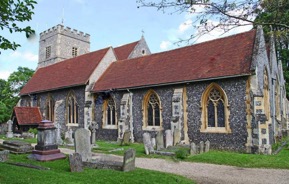
In the 10th and 11th centuries Woodley would have been a mixture of forest and marshy heathland, with very few inhabitants. However, one recorded resident was Osbertus de Woodleghe. In an ancient document called the Register of St Osmund, to be found in the archives of Salisbury Cathedral, it is recorded that Osmund, Bishop of Salisbury (Old Sarum), as Lord of the Manor, visited Sonning and, made the following decree. “Osbertus de Woodleghe holds a dwellinghouse and yard and is able to pasture his pigs on the Lord of the Manor’s woods” The date of the visit isn’t clear, but Osmund was Bishop between 1074 and 1099. The document has a date on it of 1220 but is actually a collection of older documents copied into the Register and placed in the new Cathedral at Salisbury, which was started in 1225. To date, this is the earliest written record found of habitation in Woodley, as it is not mentioned in the Domesday Book of 1086.
In the 12th century the Bishops had built a Palace for their use when visiting their Cathedral at Sonning, the remains of which are still next to the church today, and they remained Lords of the Manor until 1574 when the Manor was surrendered to Queen Elizabeth 1st.
Sonning church was dedicated to St Andrew around 1220, about the time of a restoration which included the glazing of the windows! Between 1260 and 1620 several extensions were built on to the church and during the latter part of that period came the Reformation, when Henry VIII took the church, previously under the jurisdiction of the Popes, away from Rome, and created the Church of England, appointing himself its Supreme Head. At that time Sonning church, like all other churches, became part of the Church of England, and saw the change of worship from Roman Catholic to Protestant.
Post Reformation – Church of England
For more than another 2 centuries the sparsely populated area of Woodley remained part of Sonning Parish, but in the19thcentury, when Robert Palmer of Holme Park, Sonning, owned about half of the land in Woodley, and Rev Hugh Pearson was the Vicar of Sonning, things began to change. Robert and his unmarried sisters were very wealthy benefactors of the church, and paid for a major restoration of St Andrews church in 1852
St John the Evangelist Church
After that they turned their attentions to Woodley and in 1854 the Misses Palmer paid for the building of a Church of England School in Puck’s Lane. This meant that the children of the Palmers’ tenant farmers could be educated, and Sunday School could be held in the school. However, Woodley was still in Sonning Parish and St Andrew’s was still where Baptisms, Marriages and Funerals would have to take place.
After the building of the school some Sunday Services took place there, but it was another 20 years before Woodley had its own church. In 1873 Mr Robert Palmer gave some land adjacent to the School for this purpose, and, at his expense, the Church of St John the Evangelist was built as a daughter church of St Andrew’s Sonning. At some point after this Puck’s Lane was renamed Church Road, and in 1881 the Parish of Woodley was legally formed out of Sonning Parish and St John’s became Woodley’s first Parish Church.
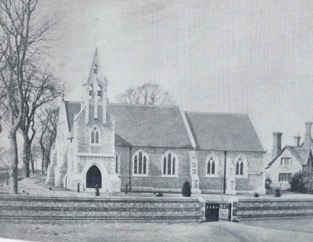
The Architect of St John’s was Henry Woodyer, of Graffham, Sussex, a well-respected church architect of his day, in the high church tradition, who had carried out the 1854 restoration of Sonning church. The Woodley church, with an exterior of stone and flint, is considered to be a good example of Woodyer’s work and has some unusual features, such as the three arch stone screen, filled with decorated iron work, and a richly ornamented cross suspended above it in the centre arch.
The style of the church is the Victorian version of Transition between Early English and the Decorated styles, and has a towering two-tier bell cote over the South Porch. The heavily sculptured stone Reredos, Pulpit and Font are all typically Victorian, but John Betjeman described the interior of the church as “lofty and graceful”. The church was fitted with wooden pews and choir stalls and had a single central aisle.
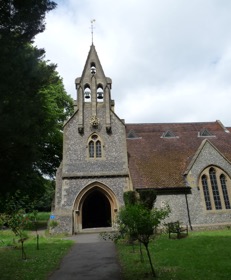
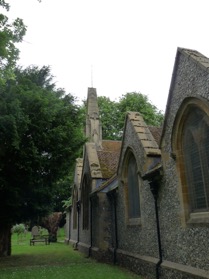
a. South door and Bellcote b. Windows
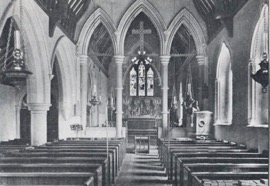
The building remained largely unaltered until 1987, when with the enormous growth of Woodley more space was required and an extension to the church was built. A local Reading architect, Grahame Solway, succeeded in designing a very sympathetic addition to the south side of the building. Viewed from the outside the appearance is really quite similar to the original, mainly because the original windows have been re-installed in the new wall, albeit that they now stand proud of the roof, dormer style. On the inside, new pillars were fashioned from concrete, to match the original stone pillars on the north side of the church, but encasing the new functional steel columns.
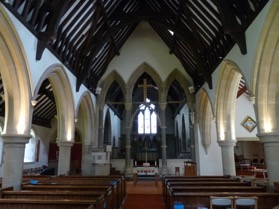
The pulpit was moved from its original position on the south side of the church, in front of the screen, to the corresponding position on the north side. The newly created space on the south side provided a new chapel and seating area, together with a new vestry, toilet, and small kitchen area at the east end. The extension nearly doubled the original seating capacity of the church and was furnished with chairs, making the space more flexible in its use.
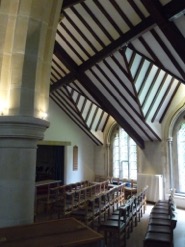
Currently (2019/20) experimental changes are being made with re-ordering the interior of the church, by removing some, and in due course, perhaps all, of the Victorian pews, replacing them with chairs thus opening up the possibility of using the church for community purposes when not needed for worship or other church meetings. A moveable Communion Table, placed in front of the Screen, for the celebration of the Eucharist, is being tried as an alternative to the original High Altar at the East end of the church. This makes for more inclusive worship, especially for disabled people.
Development of Parishes as Woodley grew in size
The Established church, the Church of England, which has the responsibility for providing pastoral care and places of worship over the whole country, has to keep pace with the increasing population. When Woodley split from Sonning in 1881, it had a population of 687, but in 2020 this is in the region of 35,000. So the 2018 revision of Ecclesiastical Parish Boundaries has seen Woodley split into three Parishes – St John’s in the north, St. James more or less covering the central area and Emmanuel in the south. The history of these additional Parishes which were gradually formed, as Woodley grew, is as follows.
In the mid 1960s St John’s established a presence in the southern part of its Parish by building a Church Hall in South Lake Crescent. To provide for the spiritual needs of the young families in this fast growing area of Woodley, St John’s moved both its Sunday School and the Mothers Union meetings to this hall. PCC and other church meetings were held there too, and so St John’s did its best to work right across Woodley from where the church was in the north to the new areas being opened up in the south of the Parsh. The outreach here continued in this way for about 25 years.
St James Church
Meanwhile, by 1969 more and more houses had been built in the South Lake area, and a new church “plant” was brought into being. This was led by some members of the congregation of St Mary’s church, in Castle St, Reading, with the co-operation of St John’s, Woodley. It met in South Lake Junior School for its first 5 years, during which time a permanent building was being planned and erected in Kingfisher Drive. Oxford Diocese purchased the land, and provided a loan towards the building and furnishings. The remainder of the cost came from generous donations and congregational fundraising.
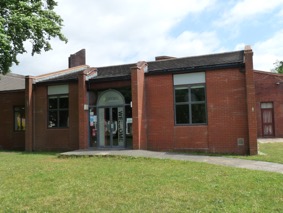
In 1974 S James’ Church Centre, in Kingfisher Drive, was opened for worship. There was continued growth in that area of Woodley and in 1984 an extension was built, and a Portacabin was brought in for the children’s work. A further extension was opened in 1991 which gave more worship space and provided an area for children, to replace the Portacabin. St James continues to be a very active church serving the local community to the present time, having celebrated its 50thAnniversary year in 2019.
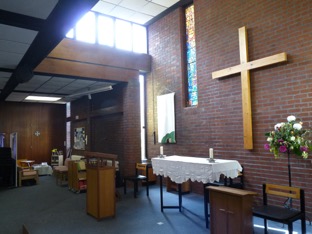
Emmanuel Church Centre
Meanwhile, in 1991, another church “plant” was started in Woodley. This was in St John’s Church Hall in South Lake Crescent, and was under the care of 11 members of St John’s congregation, together with two Church Army Evangelists. From this seed Emmanuel Church, eventually grew into the thriving church which it is today. It is active with all ages in the local community in south Woodley and to this day still meets in those same premises. Emmanuel is the third Parish to be created from the original Woodley Parish.
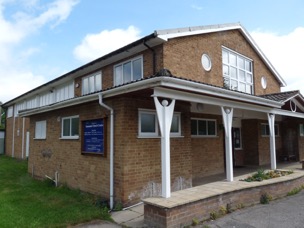
So, St John the Evangelist was the daughter church of St Andrew’s Sonning, and now St James and Emmanuel are two daughter churches of St John’s.
The Airfield Church
Another part of the Anglican, or Church of England, family in Woodley is one more church, serving yet another area of the town. This is known as the Airfield Church, which meets at the Church of England Primary School in Hurricane Way, and serves the huge housing estate built on the old airfield in the 1980s. It is a church which was “planted” jointly by St John the Evangelist and Christ Church, Methodist and URC, members, and still operates as a joint ministry. It first started under the auspices of the Woodley Council of Christians in 1993 and was more formally set up as The Airfield Ecumenical Church in 1994, with regular Sunday Services in the School from that time, which still continue. A midweek Service, home meetings and children’s work have all been added and it is still a thriving church.
Woodley’s Asian Congregation
In 2019 yet another congregation started to worship in St John the Evangelist church on Sunday afternoons. This is an Asian congregation, part of Reading Asian Christian Fellowship, who have their own Pastor, Rev Richard Christopher, and worship in their own languages. Many of them also worship with St John’s congregation and Junior Church on Sunday mornings.
Post Reformation – Roman Catholic
At the time of the Reformation, when Sonning church, like all other churches, became part of the Church of England, as explained earlier, those people who rejected the split from Rome, known as recusants, were, by law, not allowed to practise their faith openly. So they had to do it in secret, and very often they would celebrate their Masses in the chapels of large private houses. This continued for about 200 years and we have no information regarding this practice in Woodley until the end of the 18th century.
In 1777 a James Wheble built Woodley Lodge in Bulmershe and the Wheble family were very prominent Catholics. In 1801 they built their own chapel in the house and it is apparent from the records of the chapel that Baptisms and Masses were celebrated there for Catholic residents of Woodley, as well as for the Wheble family members. This continued for nearly 40 years, by which time it was legal for Catholics to have their own places of worship once more.
James Wheble gave some land which he owned, part of the old Abbey site, for the building of a new Roman Catholic Church in Reading. This church, for the RC Parish of St James, was largely paid for by James Wheble and designed by the renowned Architect Augustus Pugin. It was completed shortly after James Wheble’s death in 1840. The Parish was huge, and stretched from the R Thames in the north to the Hampshire border in the south, and from the Reading to Basingstoke railway line on the west, to the R Loddon on the east. Thus Woodley was part of that Parish.
From 1840 records show that only Wheble family members’ Baptisms, Marriages etc took place at the Woodley Lodge chapel, and all other Catholics in Woodley would have had to go to St James’ church in Reading to celebrate Mass and also for their Weddings, Baptisms and Funerals. This appears to have been the case for very nearly the next 100 years.
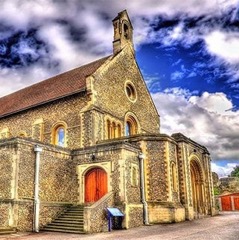
At Easter 1938 there is evidence that a Mass was said in Woodley, but not specifically recorded where it was said. However, on investigation it would seem, almost certainly, to have been held in the old East Lodge of the Wheble’s Bulmershe Estate. This single storey building was situated at the end of Beechwood Avenue, where it met Crockhamwell Road.
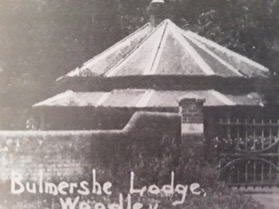
This was one of four locations spread over the large Parish of St James where, during the years between 1938 and 1946, the Mass was celebrated, for the Catholics living in these outer parts of the Parish, by the priests from St James. This was, of course, a time which was largely overshadowed by World War 2.
In 1946 the Parish of St James was officially divided into four smaller Parishes and the Roman Catholic Parish of St John Bosco, Woodley came into being. Now was the time for the Parish to have its own church, but in this immediate post-war period it was not possible to get permission to construct any completely new buildings. So, the first St Bosco church in Woodley was, in fact, an extended edition of the East Lodge, where the Catholics had been worshipping for the past 8 years.
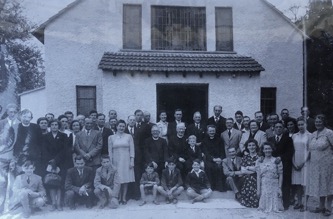
So, with a great deal of help from a Polish community which was, at that time, living in Nettlebed, the East Lodge was “extended” into a proper church. There was, in fact, very little of the original Lodge building incorporated into the new church building, but it complied with the law sufficiently to enable its construction. This church was opened on 3rdOctober 1948 and served Parishioners living in Woodley, Sonning and Earley. Whilst the building was taking place the congregation worshipped in a wooden building, which belonged to a local printer, and was situated on the other side of Crockhamwell Road, roughly where Waitrose now stands.
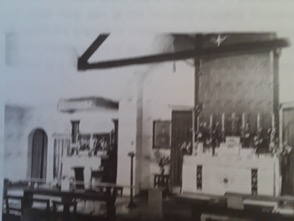
In 1956 a church hall was built adjacent to the church, and then a Presbytery, to house the Priest. The hall was extended to house classrooms for St John Bosco Convent School. However, in the mid 1960s, when Woodley’s town centre was being developed, the site of the church, hall and presbytery were wanted to complete the redevelopment of that side of Crockhamwell Road. Hence the site was sold and in April 1967 these buildings were all demolished to make way for shops in Woodley Precinct.
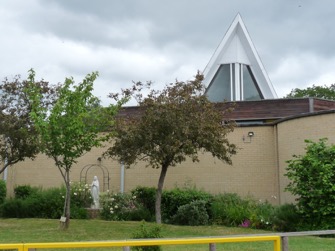
So, until the new church of St John Bosco could be built on land adjacent to the school, worship took place in the St Dominic Savio Junior School, which had been opened in Western Avenue in 1966. The new church was completed and opened in the summer of 1970, and was officially consecrated by Bishop Christopher Hollis, Bishop of Portsmouth, in 2007. In 1972 a new church was built to serve the people living in Earley and a new Parish formed there, so St John Bosco Church now serves only Woodley and Sonning.
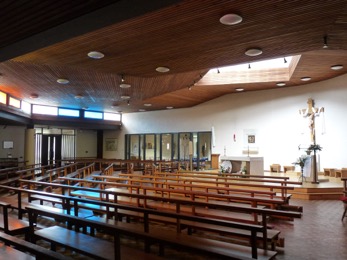
Post Reformation – Non Conformists
In the 16th and 17th centuries there were other dissenters from the Reformist Church of England – those who believed that the church had not fully reformed. They were known as Puritans and Nonconformists and considered that the Church of England had retained too many of the old Roman Catholic practices in their liturgy, and it was not pure protestantism. Oliver Cromwell, an ardent Puritan, whilst Lord Protector of the Commonwealth, passed many of the Penal Laws against the Catholics, preventing them from openly practising their faith or holding any public offices of State.
From the mid 17th century several of these non-conforming sects, including the Baptists, the Congregationalists, which included the Countess of Huntingdon’s Connexion, the Methodists and the Quakers were all very active in Reading. Nearly 200 years later, in the early 19th century, some of the nonconformist fervour reached Woodley.
Woodley Congregationalists
James Sherman, who was Minister of the Independent Chapel in Castle St, Reading, from 1821, and who was ordained in the Countess of Huntingdon’s Connexion, embarked on fervent missionary work in the villages around Reading. Thus, it was, after preaching to the villagers of Woodley, in a cottage in Wheelers Green, that he built the first “Sherman chapel” on Loddon Bridge Road in 1834, and he called it Christ Church.
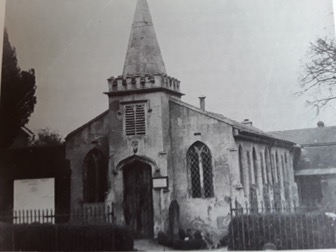
This became the first public church building in Woodley, a good 40 years before St John the Evangelist was built, and remained in use, under the wing of Castle Street Reading Congregational Chapel, for very many years. In 1972, when the Congregational Church nationally merged with the Presbyterian Church of England, Woodley chapel became a United Reformed Church. Worship continued there until 1982 when it moved to the Methodist Church. See below.
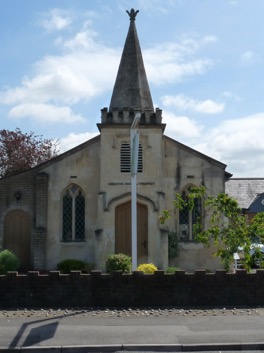
Woodley Methodists
With the ever-growing population of Woodley a Methodist congregation started to worship in Coronation Hall in 1958. It later moved to the old Secondary Modern (now Rivermead) School and in 1959 appointed their first Minister. Four years later, in 1963, the Methodists built their own church on the corner of Crockhamwell Road and Arundel Road. The building was multi-purpose i.e. it was both a worshipping space and a hall for children’s and youth organizations and activities. Later a separate hall was built on the site.
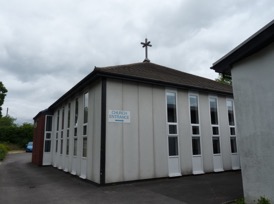
Woodley Methodists & URC
In 1982 a new, larger, building was added to the existing church, and the congregations of the Methodist and URC merged and went forward with an alternating ministry between the two churches.
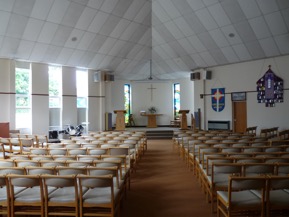
This new church was dedicated as Christ Church, presumably a reference back to the old Sherman Chapel, which had been known as Christ Church when it was first built. Almost 40 years on, this is a thriving Christian community, with several halls alongside its Worship Centre. The whole space is being used extensively by the local community throughout the week, for many different purposes, as well as by the church community for its own worship and work.
Woodley Baptists
Another church which has been part of the Christian family in Woodley for more than 40 years is Woodley Baptist Church. In 1976 a number of Baptists came together informally as a Bible Study Group meeting together in their homes. The following year they started to meet together for Sunday worship at the Methodist Church in Crockhamwell Road, at 9.30, so as to be finished before the Methodists had their own Service. In May 1979 they moved their worship to the Woodford Park Sports Pavilion, where the Referees’ changing room became the creche and the nearby Guide Hut was used for the Sunday School. At this stage the Baptists had no Minister and each member played a full part in all aspects of church life, but in November 1979, Woodley Baptist Church was formally incorporated, with this same group of less than 30 members. first Minister was appointed in January 1982. In January 1980, as numbers increased, they moved into Coronation Hall. Later a Sunday evening Service was started, and their first Minister was appointed in January 1982.
In 1986, ten years after their first home meetings, the developers of the Airfield Estate, Adwest Properties, offered Woodley Baptist Church a plot of land on the Loddon Piazza site for £1. With the land secured they began fund raising for their church building. This was completed and officially opened in March 1987. In 2001 a youth facility known as The Venue was added to part of the first floor, a facility which has had a big impact on the lives of many young people in the area over the years since. In 2005 a lift was installed, giving more inclusive access to the first floor and alterations were made to the main church entrance to accommodate it.
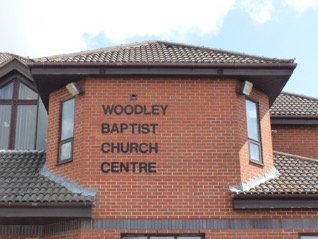
Woodley Baptist Church is affiliated to the Baptist Union of Great Britain and is a very active member of what is now called Woodley Churches Together.
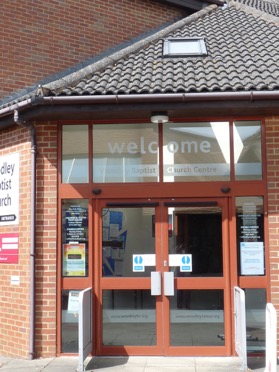
Other Christian Churches and Organisations
There is still one more active church in Woodley, probably the smallest and least known, although its former name of JAC church will be more familiar. This church sprang from the Just Around the Corner organization, which was set up with a bus in Woodley for the benefit of local young people who used to hang around Woodley Precinct with nothing much to do. JAC was started by two people from Woodley Baptist church and has an interesting story of its own in the way it has grown and developed over the years, but for the purposes of our history of churches, in more recent years they started an independent house church for teenagers. There was a group of young people who had a lot of unanswered questions following the death of one of their friends and this was a place where they could come together to seek answers from Christians who cared about them. The church outgrew the home and moved into the Woodley Airfield Youth and Community Centre, and later changed its name to Eden Church. Then, in 2017, Eden church transferred its Sunday evening Services to St John the Evangelist church, and describes itself as an Independent, All-Age church, where everyone is welcome.
Woodley is now served by three separate Anglican churches, St John the Evangelist, St James and Emmanuel, a Roman Catholic church, St John Bosco, a Baptist church and three churches which are of an ecumenical nature, combining Methodist, United Reform, Anglican and Independent traditions in Christ Church, the Airfield church and Eden church.
All these churches work closely together for the benefit of the local community under the umbrella organization known as Churches Together in Woodley, formerly Woodley Council of Christians which was set up in the 1980s. All the clergy and lay people combine to take the Christian message out into the wider community on various occasions during the year. Christmas sees Carol singing, at Easter there is a Good Friday Service in the precinct, Summer sees Praise in the Park, or the Precinct. There are joint Lent Study Groups, Pulpit exchanges, and a presence at other large local events such as the Carnival and Winter Extravaganza.
In 1997 CTinW set up a charity called Pilot Light Trust. This has several purposes, all of which are to carry out Christian service in the community. The first is the administration and running of the Woodley Foodbank, all the work for which is carried out by volunteers from the local churches, as well as the provision of the necessary space from which to operate.
The second project under the Pilot Light Trust is the REinspired programme which is specifically to help with delivering religious education in our local primary schools, using innovative ways originating from Earley & E Reading Churches Together. Volunteers from the churches are trained to deliver the programmes and are all cleared to work with children under current Safeguarding Measures. Another service which was offered under the Pilot Light Trust was a Counselling Service provided by trained volunteers to those going through difficulties in their lives. However, this service has now been discontinued.
The charity’s website also provides details of all children’s, youth, and adult groups run by all the Woodley churches at their own premises, including cafes, art and craft and friendship groups. This is a very comprehensive list, catering for all ages from cradle to grave!
As I complete this History of Woodley Churches in August 2020 the Covid-19 World pandemic is still affecting every area of people’s lives and our churches and worship spaces are no exception. By government decree all were closed in March 2020 and have only just been allowed to re-open under very strict rules. In the meantime, all churches have found ways to embrace modern technology, and worship and social gatherings have moved online.
Clergy and Ministers who have served in the Churches
To complete this history there follows lists of the very many clergy who have served the people of Woodley over the years between 1834, the official date of the first Congregational chapel, and 2020, the date this history has been compiled.
Woodley Congregational Chapel
(Independent chapel served by Ministers of the Countess of Huntingdon’s Connexion, from Castle St Reading, the first of them being Rev James Sherman, who built the chapel) 1834 – 1955
Became a joint Pastorate with Twyford Congregationalists until 1963
Rev R G Scribbins – Sep 1963 – 1967
Rev Albert Hodgkins – Oct 1967 – 1972
Rev Alan Finch – 1973 – 1978
Rev Hazel Day – Nov 1980 – Nov 1982
This church then merged with Woodley Methodist Church – see Christ Church below
St John the Evangelist, C of E Church.
Rev E A Gray – 1881
Rev John Eastgate – 1974
Rev F F Penruddock – 1913
Rev John Congdon – 1983
Rev Rhilip Gray – 1925
Rev Ian Watson – 1990
Rev Cyril Donne – 1930
Rev Fred Woods – 1996
Rev W H Trebble – 1940
Rev Ann Douglas – 2002
Rev K F Way – 1945
Rev Eddie Marquez-Picon – 2008 cont.
Rev H W H Wilkinson – 1948
St John Bosco Roman Catholic Church
Fr Daniel Rea – 1946 – 1970
Fr Joe McNerney – 2002 –2005
Fr Thomas Lane – 1946 – 1974
Fr Chris Whelan – 2005 – 2012
Fr Roy Bennett – 1974 – 1983
Fr Bonaventure Ndong – 2012 – 2017
Fr Brian Rutledge – 1983 – 1990
Fr Luca Speziale – 2017 – 2018
Fr Peter Hollins – 1990 – 1997
Fr Rafaele Cosa – 2017 – 2018
Fr Graham Attridge – 1997 – 2001
Fr Bill Wilson – 2018 cont.
Fr Bonaventure Ndong – 2001 – 2002
Fr Joe McNerney – 2002 – 2005
Woodley Baptist Church
Rev Stuart Woodward – Jan 1982 – Dec 1992
Rev David Barter – Sep 1994 – Aug 2012
Rev Andy Baker – Aug 2015 – continuing
Woodley Methodist Church
Rev C Sidney Day – Oct 1959 – August 1961
Rev George W Webber – Sep 1961 – Aug 1966
Rev S Maurice Wendt – Sep 1966 – Aug 1967
Rev Peter G Jarvis – Sep 1967 – Aug 1972
Rev David W Le Poldevin – Sep 1972 – Aug 1977
Rev Bernard Arnold – Oct 1977 – Nov 1982
This church then merged with the URC, former Congregational church – see Christ Church, below
Christ Church
Rev Bernard Arnold (Meth) Nov 1982 – Aug 1986
Rev Hazel Way (URC) Nov 1982 – March 1987
Rev Bill Mason (Meth) Sep 1986 – Aug 1993
Rev Jim Gould (URC) June 1988 – Feb 1992
Rev Audrey Simpson (Meth) Sep 1993 – July 2000
Rev Kate Pryde (URC) Sep 1993 – Feb 2001
Rev Jim Booth (Meth) (Circuit Superintendent) Sep 2000 – Aug 2001
Prof Tony Bell (Minister in training) (Meth) Sep 2000 – Aug 2001
Rev Dr Mike Hil (Meth) Sep 2001 – Aug 2006
Rev Greg Monroe (on placement from USA) for Aug 2003 only)
Rev Gordon Connell (URC) Sep 2006 – Aug 2009
(Interim Moderator)
Rev Valerie Fisher (Pastoral Minister) (Meth) Sep 2006 – Aug 2009
Rev Martyn Neads (URC) Sep 2009 – Mar 2019
Rev Dr James Mather (Meth) May 2019 continuing
St James Church
Rev John Haywood – 1974 – 1975
Rev Paul Roberts -1991 – 2003
Rev Anthony Smyth – 1975 – 1980
Rev Moira Astin – 2005 – 2011
Rev David Flagg – 1980 – 1985
Rev Nick Jackson- 2012 – 2017
Rev Kevin Roberts – 1986 – 1991
Rev Laurence Smith 2018 cont.
Emmanuel Church
Richard and Mandy Priestley (Church Army evangelists) 1991 – 2001 Rev John Honour 2003 – 2008
Rev Lyn Comerford 2001 – 2003
Rev Sean Riordan 2008 cont.
Woodley Airfield Church (Ecumenical)
Ministry is shared by Clergy/Ministers from the Methodist, URC and Anglican churches in Woodley
Eden Church
Ministry shared by a team of Pastors, including Sam & Yvonne Milligan of JAC
Sources
Books: St John the Evangelist, Woodley 1871 to 1971
The Woodley Album – Elizabeth Simmonds
Woodley in the 19th Century – Frances Lloyd
The Book of Hurst – Henry Farrar
The Story of Reading – Daphne Phillips
Websites St Andrews Church, Sonning
St John the Evangelist Church, Woodley
Christ Church, Woodley
St John Bosco Church, Woodley
St James Church, Woodley
Emmanuel Church, Woodley
Woodley Airfield Church
JAC Just Around the Corner
Churches Together in Woodley
St James RC Church Reading
David Nash Ford’s Royal Berkshire History
Salisbury Cathedral Archives
People: Paul Fahey ( Roman Catholic Parish )
Dot Butler ( Baptist Church )
Sue Karston & Margaret Lowe ( St James Church )
Members of St John the Evangelist Church
Other: Papers and documents housed in Woodley Library
Book on 70 years of St John Bosco Parish housed in the Church
Photographs
Sue Spencer – U3A Member – all images except:
St Andrew’s Sonning – from their website
St James RC Church, Reading – from their website
St John Bosco Church 1948 – unknown
St John Bosco 1948 High Altar – courtesy of Paul Fahey
Sherman chapel 1969 – from Frances Lloyd’s book
East Lodge Bulmershe Estate – from Frances Lloyd’s book
St John the Evangelist Church Exterior & Interior 1873 – from Booklet published by the church in 1971
